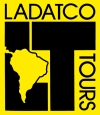

Destinations
Experiences
 |
L A
D A T C O T O U R
S |
 |
||||||||
| HOME | South America | Falkland Islands | Antarctica | Unique Destinations |
Unique Experiences |
Newsstand | ||||
|
Esteros del Ibera Argentina "Ibera" is Guarani for glittering waters. |
|
|
|
|
|
|
ABOUT ESTEROS DEL IBERÁ - from MOON HANDBOOKS Argentina Argentina’s biggest unsung attraction, Esteros del Iberá is a breathtaking wetland covering up to 13,000 square kilometers (estimates vary), nearly 15 percent of Corrientes Province. Recharged almost exclusively by rainwater, it’s really a broad, shallow river, covered by semisubmerged marsh grasses, reeds, and other water-loving plants; it flows diagonally but almost imperceptibly from the northeast toward the southwest, where the Río Corrientes enters the middle Paraná. There are also, however, open-water stretches like Laguna Iberá, a 24,550-hectare lagoon that’s protected under the Ramsar convention on wetlands of international importance. In terms of wildlife, Iberá is an American Serengeti—while it may lack the total biomass of Africa’s famous plain, the variety of species and the sheer numbers of birds, mammals and reptiles is still awesome. For these reasons, it has attracted the attention of international conservationists such as former Esprit clothing magnate Douglas Tompkins, who has purchased several estancias in the area in the hopes of preserving their natural wealth. http://theconservationlandtrust.org And Iberá needs defenders, as the marshes have a fragile ecology imperiled by mega-hydroelectric developments of the Yacyretá dam, north of the city of Ituzaingó. As runoff from Yacyretá’s rising reservoir seeps into Iberá, deepening waters threaten to break the link between the marsh vegetation and the dissolved sediments from which the plants derive their nutrients. Orientation Getting there: It is also possible to fly from Posadas directly to the air strip at Estancia Rinconc del Socorro, if you are staying there. The flight is via single engine 4 seater air craft, about 1 hour 15 minutes. |
Flora and Fauna
Iberá’s flora and fauna make it a wonderland of biodiversity. Scattered
open-water lagoons lie within an endless horizon of marshland grasses, aquatic plants, and
embalsados (“floating islands”), which some ecologists have compared to tropical
peat bogs. Even relatively large trees like the seibo (Erythrina cristagalli) and laurel
(Nectandra falcifolia) flourish here and in gallery forests along faster-flowing waters.
Biologists have catalogued over 40 species of mammals, 35 species of amphibians, 80 species of fish, and 250–300 species of birds. The most readily seen mammals are the carpincho (capybara, Hydrochaerus hydrochaeris), marsh deer (Blastoceros dichotomus), and pampas deer (Ozotocerus bezoarticus; the mono carayá (Alouatta caraya, howler monkey) is more easily heard than seen. Less easily seen are the lobito de río (Paraná otter, Lontra longicaudis) and the largely nocturnal aguará guazú (maned wolf, Chrysocyon brachyurus).
Among the reptiles, there are two species of caimans, the yacaré overo (Caiman latirostris) and the yacaré negro (Caiman yacare). Australians, take note: these skinny, meter-plus creatures are not the massive crocodiles of Queensland and the Northern Territory, and will not pounce out of the swamps in search of human nourishment. The endangered water curiyú (water boa, Eunectes notaeus) is also present.
Birds are far too numerous to mention more than a sample, but the signature species include the chajá (horned screamer, Chauna torquata), mbiguá común (olive cormorant, Phalacrocorax olivaceus), several species of storks, herons, and egrets, and many waterfowl, including the endangered pato crestudo (comb duck, Sarkidiornis melanotos).
Go Prepared:
Be sure to take with you protection from the rain and from the sun and good walking shoes,
which you can clean and which will dry rather quickly. Bonoculars are recommended.
Between June and September, it can be quite cool, so you should have a jacket and the
ability to layer clothing. There are no shops or gear stores so bring all you need.